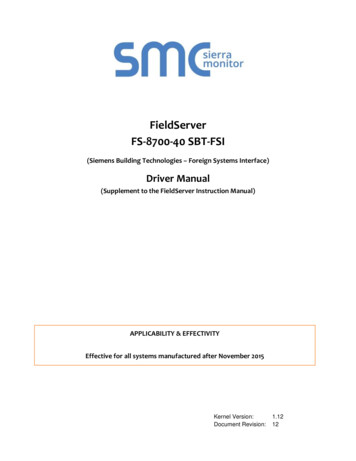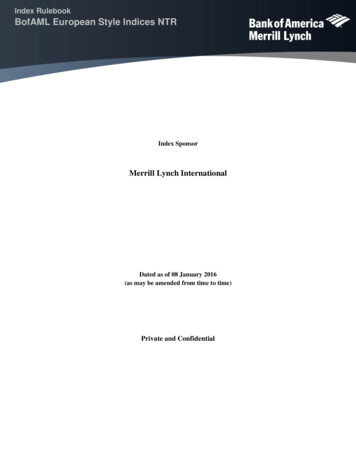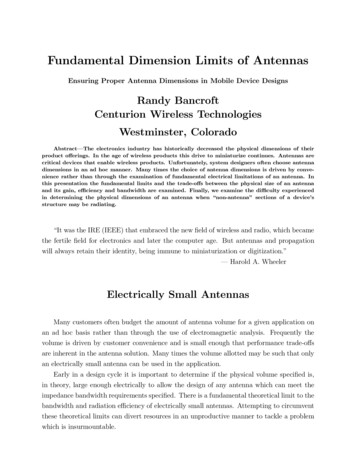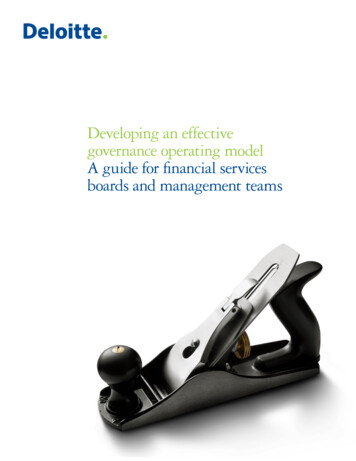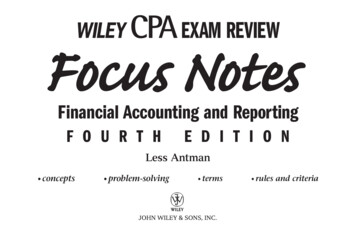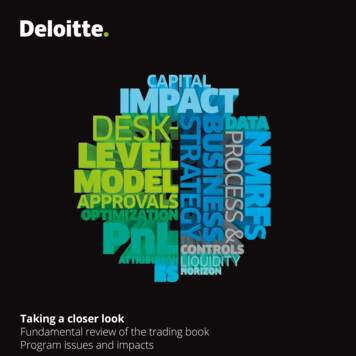
Transcription
Taking a closer lookFundamental review of the trading bookProgram issues and impacts
Taking a closer look Fundamental review of the trading book: Program issues and impactsBank-wide impact of the FRTBThe impact of the fundamental review of the trading book (FRTB) will be felt well beyond risk, with front office, finance andIT all heavily affected. There are three key impacts:1. Capital impact and business strategyBanks must respond to the capital changes caused by the FRTB – the impact must be fully understood, and used toshape future business strategy.2. Processes and controlsThe FRTB introduces major front-to-back office framework changes, such as enhanced disclosure and increasedrequirements for risk-finance alignment. A robust set of FRTB-compliant processes and controls is key.3. IT, data and implementationSystems across risk, finance and front office will require development work, and early documentation ofrequirements is essential to ensure nothing is missed.The timeline for the FRTBThe new regulation comes into force for capital requirements at the end of 2019, with transitional arrangements and parallelcalculations from January 1st that year.Final rules published– Jan 201620161Parallel run phasecould begin as earlyas Jan 20182017Submit internalmodels applications– Jan 20192018Rules adopted intolegislation – Jan 2019FRTB used for capital– Jan 202020192020Regulatory QIS usingDec 30 2015 dataRegulatory QIS usingJan 30 2016 dataPotential for misalignment of regulatorygo-live datesDesignImplementParallel run and applicationsRegulatoryremediation
Taking a closer look Fundamental review of the trading book: Program issues and impactsRegulatory uncertainty – areas of impactImportant aspects of the rules are still very much open to interpretation. This leaves banks with a dilemma: is the bestapproach to implement the rules under the current interpretation, or await further clarification and risk missingthe deadline.Profil and loss (P&L) AttributionThere is currently ambiguity as to whether risk theoreticalP&L needs to be calculated using risk models or frontoffice pricing models and whether Hypothetical P&L canbe measured by front office or needs to be calculatedindependently by finance. Different interpretations lead tovery different implementation choices and costs, and couldgive rise to very different outcomes in banks’ ability to usethe internal models approach.2Non-Modellable Risk Factors (NMRF)A conservative interpretation of the requirements such ascategorizing every unobservable risk factor as an individualNMRF, quickly leads to prohibitive levels of capital. Mitigatinginitiatives, such as finding a “golden source” of market data,would add significant time and expense to implementation.Lack of technical clarification could result in widely diverginginterpretation and risk weighed assets (RWA) levels in theindustry, which is precisely what the FRTB has intended to avoid.
Taking a closer look Fundamental review of the trading book: Program issues and impactsDeveloping an FRTB-efficient front officeTrading desks are likely to move between the sensitivity based approach and the internal models approach, and so the frontoffice will want input into market risk setup – regulatory compliance must be achieved in a way that benefits the business.Banks must focus on maximizing desks with IMA approval, and then ensuring that they remain approved.The number one driver of IMA approval will be how each desk performs on backtesting and P&L attribution tests. Therefore, making theright decisions around desk structure and desk size are key:Bigger desksMore likely topass P&L andbacktestingtestsLess granularreporting /disclosureobligations3Smaller desksLower resourcecost cationprocessLess impactfrom deskfailureEasier to quarantinestrategies that test badlye.g., exotics for P&Lattribution and newbusiness P&L forbacktestingEasier to makelegal entityspecificEasier to restore hedgesby raising liquidityhorizons of hedginginstruments to matchthat of the hedgedinstrument
Taking a closer look Fundamental review of the trading book: Program issues and impactsFRTB programs across the industryWorkstreamsFRTB program design structures vary widely across the industry and are often influenced by how firms are set upinternally. The key is to ensure core program principles are followed together with groupings of deliverables thatmaximize synergies. Examples of program structures across the industry include:(1) Large European bank(2) Large UK bank(I) Front office(I) Reporting and disclosure(II) Models and methodology(II) TB/BB boundary(III) IT and infrastructure(IV) Process and controls(V) Data(VI) QIS and analytics(III) Desk-level tests(IV) Front-office desks(V) IMA expected shortfall(VI) IMA NMRFs(VII) IMA default risk(VII) Regulatory liasion(VIII) Reporting and disclosure(VIII) Finance(IV) Standardized approachIt is equally important that the onerous requirements under FRTB are met with a strategic response – major design decisions andpriorities should be informed by the business, which means that a parallel strategic work stream must not be overlooked.Strategic workstreamThe strategic work stream should require significant input from the front office to avoid missing an opportunity to streamline front officeprocesses, which can minimize RWA impact over time. Examples of key strategic decisions include: Defining a new regulatory desk structure. This raises questions about legal entity and hedging model. Shaping the business response to changing capital requirements. Decisions as to priorities for model approval and implications for the implementation timeline. Defining KPIs for the risk appetite and various risk metrics under the new regime.4
Taking a closer look Fundamental review of the trading book: Program issues and impactsChallenges facing smaller banksHeadingGiven the work required to implement even the standardized approach, every bank with a trading book has atough task ahead.5Standardized approachInternal models approachIn the past, banks opting for the standardized approachmay have avoided the more onerous requirementstypically associated with internal models. However,requirements under the FRTB SA means that this is nolonger the case.Requirements for desk-level approval and on-going deskeligibility tests will likely be challenging. For banks lackingthe sufficient experience in developing, validating andbacktesting internal models, there is an extra layer ofcomplexity.In addition to front office sensitivities, the standardizedapproach requires good quality static data to beassociated with each risk factor. For example, industrysector, region, market capitalization and credit rating areall required attributes. Some of these inputs may not yetexist in production therefore, depending on the bank’scurrent capabilities, significant technical enhancementsmay be required.This could lead to banks specializing in a particularproduct offering, potentially with exotic type derivativesthat pose potential difficulties in backtesting beingwithdrawn.
Taking a closer look Fundamental review of the trading book: Program issues and impactsFRTB – CVA (Credit Valuation Adjustment)HeadingRegulators are consulting on a overhaul of the current CVA VaR framework. The most recent proposal aims to drawa conceptual parallel with FRTB market risk by introducing a sensitivities based approach for SA-CVA, but alsoforbids the use of IMA-CVA, narrowing down the available design choices.Replacement of internal models by anadvanced standardized approachThe FRTB-aligned SA-CVA will act as thenew ‘advanced approach’ for banks thatmeet the minimum requirements, with ahighly conservative fall-back on the basicapproach (BA-CVA).What the standardized model has instore is far from trivialThe standardized approach (SACVA), analogous to its FRTB marketrisk counterpart, uses internal CVAsensitivities as inputs. This is far from atrivial requirement, and the production ofreliable CVA sensitivities to market risk factorswill prove challenging even for the most sophisticated banks.For this reason, banks should anticipate considerablesupervisory oversight – there is likely to be a high-burden ofproof to demonstrate SA-CVA eligibility and this should befactored into remediation efforts.Fallback on basic is expected to havematerial capital impactAbsent a drastic recalibration, BA-CVA isexpected to be prohibitively expensiveat 5-7x current standardized CVA charge.For a bank wishing to remain active in theOTC space, SA-CVA is a non-negotiable,high-priority item.6Roadmap to the required future stateThe proposed CVA changes representa material departure from the existingapproach and the gap betweenbanks’ current state and supervisoryexpectations is significant. Meeting therequirements would likely require a vastbody of remedial work, centrallycoordinated across risk, finance, front officeand IT
Taking a closer look Fundamental review of the trading book: Program issues and impactsImpact of the trading book/banking book boundaryRegulators are establishing a more objective boundary to mitigate capital arbitrage between the regulatory tradingbook and banking book. The rules governing the treatment of internal risk transfers (IRT) across the boundary are nowfar more onerous – meeting these requirements may likely be costly while on-going compliance presents a wide rangeof significant challenges.Exposure to muchgreater supervisoryscrutinyBanks will need toconsult more activelywith supervisors thanis the case today.Supervisors will reviewand in some cases,have the right to rejectrisk managementstrategies and specifictransactions.7Reduced flexibilitylikely leads to highercostsRestrictions on transfersbetween the regulatorybooks will likely increasecapital requirements.The new IRT ruleseffectively reduce orremove any capitalbenefit resulting frombeing a universal bank.The need to matchexternal hedges to IRTscan be costly and raisesquestions as to whetherthis can provide themarket with increasedvisibility into the bank’sbanking book hedgingstrategies.Increased publicdisclosuresRe-designationsbetween the differentregulatory books, ifpermitted at all, willbe subject to publicdisclosures.Enhancements toexisting systems andcontrols is requiredBanks will be expectedto implement andmaintain a robustsystems and controlframework to ensuresegregation betweenthe regulatory booksat all times. Adequatesystems are requiredto identify and mapexternal hedges withtheir correspondingIRTs.Documentation andrisk managementStandardized approachbanks will be subjectto more onerousdocumentation and riskmanagement standardswith respect to themaintenance of theboundary.
Taking a closer look Fundamental review of the trading book: Program issues and impactsKey insights: Capital impactAn appropriate methodology for allocating capital across specific desks and business areas isa valuable tool for understanding the key drivers – this could shape a bank’s strategic responseto the FRTB.Impact Analysis can lead to valuable insightLimited diversification results in capital ‘smoothing’ across desks The move from single portfolio-wide VaR and sVaR to multiple asset class and liquidity horizoncalculations ‘smooths’ capital across desks As a result, fewer desks suffer very high or very negative capital costsFRTB expected shortfall vs. VaR sVaR FRTB ESDesk 6The capital intensive desks in thecurrent model tend to be slightlyreduced under the FRTB, with onlya few desks suffering a significantincrease.Desk 7Desk 5 Desk 1Desk 20Desk 3 Desk 4 Desks that had provideddiversification under the currentmodel, no longer do under FRTB.VaR sVaRResultMany banks may have to completely rethink how they hedge their exposure, and could heavilyimpact certain desks business models.8
Taking a closer look Fundamental review of the trading book: Program issues and impactsHeadingRaising liquidity horizons can reduce capital The use of multiple liquidity horizons can break hedges, with ‘more liquid’ risk factors dropping out ofexpected shortfall calculations. Despite the larger scalar multiplier associated with higher liquidity horizons, it can actually be beneficial torestore hedges by raising these horizons (e.g., FX from 10 day to 20 day horizons, or credit frominvestment grade to high yield) Increasing liquidity horizons alone can reduce capital by 5–10 percent.EquitiesDeskDesk ADesk B102040-11.30 -10.80 6.300.000.000.00FX601201020All asset classes4060120102040601206.600.00 -0.50 6.401.501.400.00 -29.00 -12.30 16.40 13.80 0.000.000.00 -5.50 0.401.501.000.00 -13.20 -2.80 1.501.900.00 The table shows an illustrative case in which a detailed decomposition of the capital charge – by desk, assetclass and liquidity bucket – shows the offset between equity spot and Vol being broken by liquidity buckets– a clear candidate for raising of horizons.ResultBanks will need the appropriate tools to identify exactly where to raise liquidity horizons, andassess its impact on capital.9
Taking a closer look Fundamental review of the trading book: Program issues and impactsFRTB is, in many ways, farmore complex than theexisting framework.It is important for banks andregulators to engage with eachother early, to avoid duplicatingefforts and mitigate the significantpotential of unintendedconsequences associated withany major regime change.10
Taking a closer look Fundamental review of the trading book: Program issues and impactsKey insights: Capital optimizationHeadingBanks that take the opportunity offered by the FRTB to optimize their front office, rather than just ‘get over theline,’ will likely be at a distinct advantage in the post FRTB world.An initial view on desk structure and optimization could be formed relatively quickly using prototype models and desk eligibility testresults. Here we outline a general approach to consider, which could be modified depending on progress already made on each stage.12Preparation: Automate prototype models and datafeeds; Agree allocation methodologyCapital impact and optimization decisions will need to betested over a variety of scenarios over time. This requiresan agreed top-down allocation methodology and financedata to estimate risk factor contributions to capital.Iterative testing of optimization approachesIt is important to agree key design principles and set inmotion an ongoing process of iterative optimization.The process must be both data-driven and guided bycareful judgement. Ongoing improvement of prototypemodels and desk eligibility tests is essential if results are tobe meaningful.FRTB may require a fundamental rethinking of manybusiness structures and operating models. But capitaloptimization should aim to streamline these, rather thanadd complexity and opacity.11
Taking a closer look Fundamental review of the trading book: Program issues and impacts34Stakeholder engagementAny reshape of the front office will need buy-in from acrossthe business. More detailed decisions about trading andhedging strategies will need to be taken by the businessnot the FRTB analysis.The result: A toolkit for ongoing optimizationOptimization and strategic restructuring will take placeup to – and beyond – FRTB go-live. The aim of an initialstrategic analysis cannot be to find all the answers, butrather to define an approach and toolkit for ongoingoptimization and secure agreement across the bank as tothe scale of change required.In addition to impact on RWA, each optimizationdecision needs to be assessed along three key businessdimensions:1. Cost impact of optimization2. Optimization fitsspirit of FRTB rules3. Optimization logicalfor business12312
Taking a closer look Fundamental review of the trading book: Program issues and impactsDeloitte Global FRTB contactsGlobal Financial Services LeadershipRobert ContriGlobal Leader, Financial ServicesIndustry DTTL 1 212 436 2043bcontri@deloitte.comAnna CelnerGlobal Leader, Banking andSecurities DTTL 41 58 279 6850acelner@deloitte.chRick PorterGlobal Leader, Financial ServicesRisk Advisory DTTL 1 561 962 7792rickporter@deloitte.comEdward HidaGlobal Leader, Risk and CapitalManagement DTTL 1 212 436 4854ehida@deloitte.comZeshan ChoudhryPartner – Deloitte United Kingdom 44 20 7303 8572zchoudhry@deloitte.co.ukCraig BrownManaging Director –Deloitte United States 1 212 436 3356cbrown@deloitte.comFRTB Global Leads13
Taking a closer look Fundamental review of the trading book: Program issues and impactsFRTB country specialistsAustraliaKevin NixonPartner – Deloitte Australia 61 2 9322 7555kevinnixon@deloitte.com.auFranceFrederic BujocPartner – Deloitte France 33 1 55 61 23 83fbujoc@deloitte.frTimothy OldhamPartner – Deloitte Australia 61 2 9322 5694toldham@deloitte.com.auSamuel FeronDirector – Deloitte France 33 1 55 61 79 60sferon@deloitte.frSteven CunicoPartner – Deloitte Australia 61 3 9671 7024scunico@deloitte.com.auGermanyJoerg EngelsPartner – Deloitte Germany 49 211 8772 2376jengels@deloitte.deBrazilRodrigo Mendes DuartePartner – Deloitte Brazil 55 11 5186 6206rodrigomendes@deloitte.comFrank MuellerDirector – Deloitte Germany 49 697 5695 6225frmueller@deloitte.deCanadaAzer HannPartner – Deloitte Canada 1 416 601 5777ahann@deloitte.caItalyPaolo GianturcoPartner – Deloitte Italy 39 028 332 3209pgianturco@deloitte.itMario El-khouryPartner – Deloitte Canada 1 416 601 6091mareelkhoury@deloitte.caJapanTsuyoshi OyamaPartner – Deloitte Japan 81 90 9834 4302tsuyoshi.oyama@tohmatsu.co.jpRobert CranmerDirector – Deloitte Canada 1 416 775 8669rcranmer@deloitte.ca14
Taking a closer look Fundamental review of the trading book: Program issues and impactsLuxemburgPeters Jean PhilippePartner – Deloitte Luxemburg 352 45145 2276jppeters@deloitte.luUnited KingdomZeshan ChoudhryPartner – Deloitte United Kingdom 44 20 7303 8572zchoudhry@deloitte.co.ukMartin FlaunetPartner – Deloitte Luxemburg 352 45145 2334mflaunet@deloitte.luDaniel MayerSenior Manager – Deloitte United Kingdom 44 20 7007 2566dmayer@deloitte.co.ukSouth AfricaWayne SavagePartner – Deloitte South Africa 27 11 209 8082dsavage@deloitte.co.zaPeter McCloskeyDirector – Deloitte United Kingdom 44 20 7007 3620pmccloskey@deloitte.co.ukMonique De WaalSenior Manager – Deloitte South Africa 27 11 304 5417modewaal@deloitte.co.zaFrancesco BellasiDirector – Deloitte United Kingdom 44 20 7007 1756frbellasi@deloitte.co.ukUnited StatesEdward HidaPartner – Deloitte United States 1 212 436 4854ehida@deloitte.comCraig BrownManaging Director – Deloitte United States 1 212 436 3356cbrown@deloitte.comSean HirschSenior Manager – Deloitte United States 1 213 553 3103sehirsch@deloitte.com15
Deloitte refers to one or more of Deloitte Touche Tohmatsu Limited, a UK private companylimited by guarantee (“DTTL”), its network of member firms, and their related entities.DTTL and each of its member firms are legally separate and independent entities. DTTL(also referred to as “Deloitte Global”) does not provide services to clients. Please seewww.deloitte.com/about to learn more about our global network of member firms.Deloitte provides audit, consulting, financial advisory, risk management, tax and related servicesto public and private clients spanning multiple industries. Deloitte serves four out of five FortuneGlobal 500 companies through a globally connected network of member firms in more than 150countries bringing world-class capabilities, insights, and high-quality service to address clients’most complex business challenges. To learn more about how Deloitte’s approximately 225,000professionals make an impact that matters, please connect with us on Facebook, LinkedIn, or Twitter.This communication contains general information only, and none of Deloitte Touche TohmatsuLimited, its member firms, or their related entities (collectively, the “Deloitte Network”) is,by means of this communication, rendering professional advice or services. Before makingany decision or taking any action that may affect your finances or your business, you shouldconsult a qualified professional adviser. No entity in the Deloitte Network shall be responsiblefor any loss whatsoever sustained by any person who relies on this communication. 2016. For information, contact Deloitte Touche Tohmatsu Limited.Designed and produced by The Creative Studio at Deloitte, London. J8069
Fundamental review of the trading book Program issues and impacts. Bank-wide impact of the FRTB. The impact of the fundamental review of the trading book (FRTB) will be felt well beyond risk, with front office, finance and . The strategic work stream should require significant input fro

